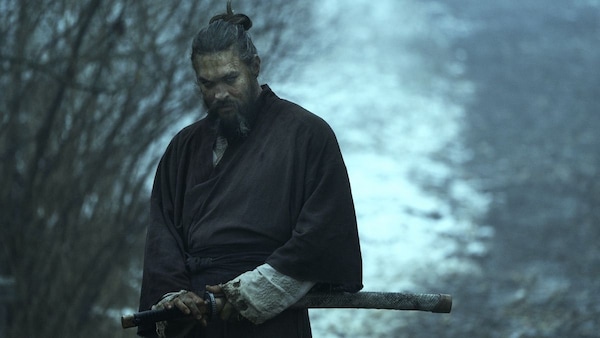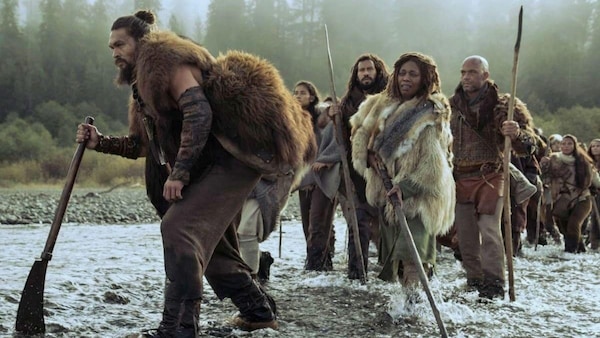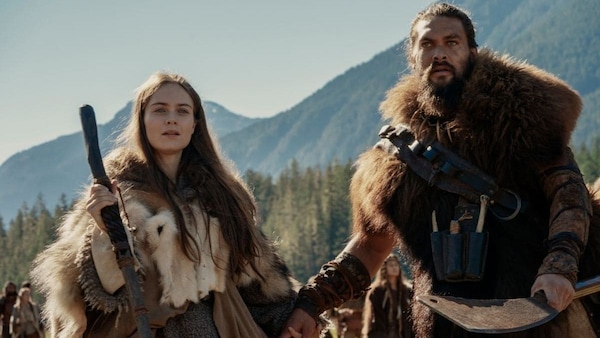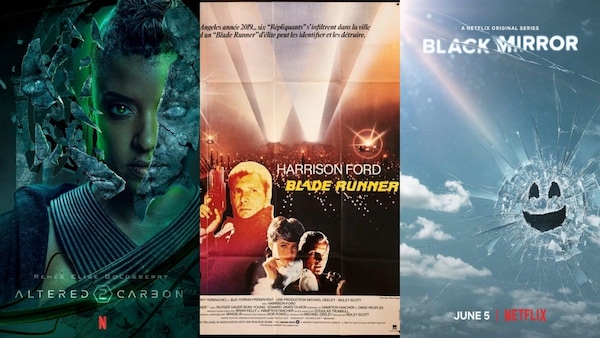See: Reflections on Jason Momoa’s genre-redefining Apple TV+ series and dystopian drama
See, starring Jason Momoa in the lead, borrows bits from every dystopian thriller to offer an introspective tale on greed.

Last Updated: 02.31 PM, Jun 09, 2023
Season 2 of the 2019 Apple TV+ dystopian series See just concluded. It stars Jason Momoa as Baba Voss, a blind warrior of a dystopian society where humans have lost the power of sight.
Season 1, which dropped on November 2019, opens with an action sequence where the Alekenny village, of which Baba Voss is the chief warrior, is being attacked by Witchfinders. They belong to an elite force sent by Queen Kane (played by Sylvia Hoeks) to look for babies who have ‘Sight’. It's interesting that the narrative doesn’t waste too much time in explaining where the viewer is and what is happening. Within no time we learn that the story is of a distant future where humankind has lost the ability to ‘See’, and now depends solely on heightened senses of hearing, smell and intuition.
The opening battle scene between two visually-impaired armies is innovatively choreographed and skillfully directed by Francis Lawrence, who has to his credit the acclaimed Hunger Games movie franchise.
The story, in short, is thus — Baba Voss has to save his adoptive twin children, Kofun and Haniwa, from the Queen Kane’s Witchfinders, led by an astute and sharp general Tamacti Jun (played by Christian Camargo), a ruthless warrior who would not hesitate to kill anyone who comes in the way of his mission.
The world of the sightless is cold and bleak, and humankind has returned to its primitive state. We are told technological advancement not only made us masters of the known world but somehow propelled us to be greedier, leading us to becoming blind. It’s a warning of sorts to humankind — turn a blind eye to humanity, and you may actually lose your sight.
Everything that the characters ‘do’ in the film have to have an aural ‘signature’ to them. Only then can the characters interact, whether while fighting, eating or simply walking. Different sounds indicate different actions. At first, this would seem restrictive, but the series has elaborately captured how this can also become an advantage. For example, by not relying on sight, a well-trained 'blind warrior’ knows how to anticipate the next blow simply by concentrating on other signs like breath and smell. It makes one wonder how much we, in the present, ignore our other senses and rely solely on sight for our everyday functions. Today, we live in a world of fake news, where ‘seeing is believing'. But in the post-truth world, truth itself does not have a singular definition.

By the time we reach the end of Season 1, it's revealed that Margha is actually Queen Kane’s sister and the true heir to the throne.
Season 2 opens with new characters being introduced, with a new adversary for Baba Voss. His brother Edo Voss (Dave Bautista) seeks revenge on Baba Voss for betraying and killing their father.
It culminates into an epic battle between the Trivantians and the Payans, who are led by Tamacti Jun and Baba Voss. The season obviously cannot but end without an epic battle between the two Voss brothers. No points for guessing who wins.
Throughout the narrative, the viewer is reminded time and again that having sight is not necessarily a blessing. In fact, the blind are more sensitive to their surroundings by relying on their other senses.

See is a fictional yet terrifying vision of the future where humankind has caused its own destruction; it is a metaphor for how extreme modernisation and greed will eventually destroy the planet. It is a literal ‘loss of (fore)sight’.
A lot of the production design will remind you of scenes from another dystopian cult classic, the Mad Max series. A lot of the costumes and weaponry is also reminiscent of the Australian post-apocalyptic action film series, including the central plot of warring ‘tribes’ who are constantly battling each other with rudimentary weapons for survival.

Dystopian fictional series can broadly be divided into 4 genres. There is the “Ideological dystopian future” like The Handmaid’s Tale, where a certain ideology, typically anti-human and regressive, takes over the world. The aim of the protagonist is to first survive the regressive regime and then upend it.
The second genre is the “technological dystopia”, in which technology takes control of human society. Altered Carbon, Black Mirror or the cult classic Blade Runner are some of the titles in this genre. The idea is to convince the viewer of a dark futuristic world that has killed the human spirit through technological advancement. The protagonist defeats “technology” by using its own drawbacks, pushing it to its collapse.
The third genre is the “environmental dystopia”. In this genre, the earth is depicted as a wasteland, caused by rampant exploitation of natural resources. Humankind is left to its own devices to survive a harsh and unforgiving environment. As mentioned earlier, one of the prime examples of this genre is the Mad Max franchise, where scarcity of water is depicted as one of the prime concerns in the post-apocalyptic world.
The fourth genre is the “physiological dystopia”, in which humans change their form and mutate into a different being. Take for example, zombie films, where a virus transforms deceased humans into flesh-eating monsters. There are many films and series under this genre, the most popular being The Living Dead. It's this genre that the Apple TV+ series See belongs to.

However, the unique thing about See is that it borrows bits from every genre to render a compelling human drama of good versus evil. The characters of See have flaws and shortcomings — they have either lied or betrayed a close one to survive. But the audience can empathise with the characters at all times. In one moment, you hate Tamcti Jun, but a few episodes later, you sympathise with him. Similarly, much like the Greek heroes, Baba Voss is your typical hero warrior, but not without flaws. Then, there is Queen Kane, who is projected as conniving and cunning at first, but later shown to be misunderstood.
It's this interweaving of human drama and emotions that makes See such a compelling watch. The dystopian nature of the world is not overemphasised, but just when you think it's all about emotions, the narrative throws up the issue of blindness.
In the end, the series makes one think of the transient nature of everything one takes for granted. I think the coronavirus pandemic has led humankind to introspect about the future. This is what makes See a relevant story of our times.
(Views expressed in this piece are those of the author, and do not necessarily represent those of OTTplay)

